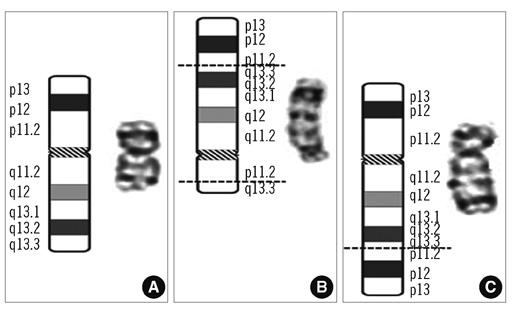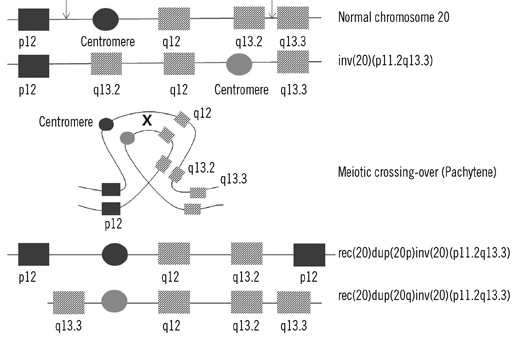Ann Lab Med.
2012 Jan;32(1):91-94. 10.3343/alm.2012.32.1.91.
A Case of Partial Trisomy 20p Resulting from Meiotic Recombination of a Maternal Pericentric Inversion
- Affiliations
-
- 1Department of Laboratory Medicine, Pusan National University School of Medicine, Busan, Korea. csm410@naver.com
- 2Department of Pediatrics, Pusan National University School of Medicine, Busan, Korea.
- 3Department of Laboratory Medicine, Center for Clinical Oncology, Research Institute and Hospital, National Cancer Center, Goyang, Korea.
- KMID: 1781445
- DOI: http://doi.org/10.3343/alm.2012.32.1.91
Abstract
- Here we report the cytogenetic and clinical manifestations observed in a patient with a rec(20)dup(20p)inv(20)(p11.2q13.3)mat. The patient was a full-term newborn girl with asymmetric intrauterine growth restriction and multiple congenital malformations, including a ventricular septal defect, pulmonary atresia, ambiguous genitalia, clinodactyly, and sacral dimpling. To our knowledge, this is the 4th report in the world and the 1st one in Korea of a patient with rec(20)dup(20p).
MeSH Terms
Figure
Reference
-
1. Shaffer LG, Slovak ML, editors. ISCN 2009 : An international System for Human Cytogenetic Nomenclature (2009). 2009. Basel: Karger.2. Lucas J, Le Mée F, Le Marec B, Pluquailec K, Journel H, Picard F. Trisomy 20p derived from a maternal pericentric inversion and brachymesophalangy of the index finger. Ann Genet. 1985. 28:167–171.3. Bown N, Cross I, Davison EV, Burn J. Partial trisomy 20p resulting from a recombination of a familial pericentric inversion. Hum Genet. 1986. 74:417–419.
Article4. Descipio C, Morrissette JD, Conlin LK, Clark D, Kaur M, Coplan J, et al. Two siblings with alternate unbalanced recombinants derived from a large cryptic maternal pericentric inversion of chromosome 20. Am J Med Genet. 2010. 152A:373–382.
Article5. Molina-Gomes D, Nebout V, Daikha-Dahmane F, Vialard F, Ville Y, Selva J. Partial trisomy 20p resulting from recombination of a maternal pericentric inversion: case report of a prenatal diagnosis by chorionic villus sampling. Prenat Diagn. 2006. 26:239–241.
Article6. Oppenheimer S, Dignan P, Soukup S. Partial trisomy 20p: familial occurrence. Am J Med Genet. 2000. 95:316–319.
Article7. Grammatico P, Cupilari F, Di Rosa C, Falcolini M, Porto GD. 20 p duplication as a result of parental translocation: familial case report and a contribution to the clinical delineation of the syndrome. Clin Genet. 1992. 41:285–289.
Article8. Sidwell RU, Pinson MP, Gibbons B, Byatt SA, Svennevik EC, Hastings RJ, et al. Pure trisomy 20p resulting from isochromosome formation and whole arm translocation. J Med Genet. 2000. 37:454–458.
Article9. Schinzel A. Trisomy 20pter to q11 in a malformed boy from a t(13;20) (p11;q11) translocation-carrier mother. Hum Genet. 1980. 53:169–172.
Article10. Taylor KM, Wolfinger HL, Brown MG, Chadwick DL, Franche U. Partial trisomy 20p derived from a t(18;20) translocation. Hum Genet. 1976. 34:155–162.
Article11. Balestrazzi P, Virdis R, Frassi C, Negri V, Rigoli E, Bernasconi S. "De Novo" trisomy 20p with macroorchidism in a prepuberal boy. Ann Genet. 1984. 27:58–59.
- Full Text Links
- Actions
-
Cited
- CITED
-
- Close
- Share
- Similar articles
-
- A Case of Trisomy 10p with Vertebral Anomaly and Hypospadias
- Repetitive Pregnancy Loss in inv(22)(p13q12) Carrier
- Recurrent Partial Trisomy 1q in Maternal Balanced Translocation t(1;11)(q32;q23)
- A case of partial trisomy 22 due to paternal 11;22 translocation, t(11;22)(q25;q13.1)
- A Case with Partial Monosomy 6q and Partial Trisomy 14q Derived from Maternal Balanced Translocation



